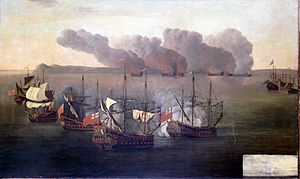HMS Centurion (1650) facts for kids

Commodore Richard Beach and Dutch Admiral Van Ghent in a joint task force destroy six Barbary ships near Cape Spartel, Morocco, 17 August 1670, Centurion is at the far left
|
|
Quick facts for kids History |
|
|---|---|
| Name | Centurion |
| Ordered | December 1649 |
| Builder | Peter Pett I, Ratcliffe |
| Launched | 1650 |
| Commissioned | 1650 |
| Honours and awards |
|
| Acquired | May 1660 |
| Honours and awards |
|
| Fate | Wrecked in a storm 25 December 1689 |
| General characteristics | |
| Class and type | 42-gun Fourth rate |
| Tons burthen | 531⁄58 tons (bm) |
| Length | 104 ft 3 in (31.8 m) keel for tonnage |
| Beam | 31 ft 0 in (9.4 m) |
| Depth of hold | 15 ft 6 in (4.7 m) |
| Propulsion | Sails |
| Sail plan | ship-rigged |
| Complement |
|
| Armament |
|
HMS Centurion was a powerful warship built for the Commonwealth of England in 1650. It was a "fourth-rate frigate," which meant it was a medium-sized warship with lots of guns. When the monarchy returned to England in 1660, the ship became part of the Kingdom of England's navy.
Centurion was the very first ship in the English and Royal Navy to be given this name. It saw action in many important battles, including the First Anglo-Dutch War and the Second Anglo-Dutch War. It also sailed to the Mediterranean Sea to fight against pirates. Sadly, the ship was lost in a big storm in 1689.
Contents
Building a Warship: Centurion
Centurion was one of six frigates ordered in December 1649. It was built by Peter Pett I in Ratcliffe, England. The ship was launched in 1650, meaning it was put into the water for the first time.
The ship was about 104 feet long and 31 feet wide. It weighed around 531 tons. When it was first built, Centurion carried 50 guns. Over the years, the number and type of guns changed slightly. For example, by 1681, it had 52 guns. These guns included large cannons called culverins and smaller ones like sakers. The ship usually had about 180 sailors on board to operate it.
Centurion began its service in 1650 under Captain William Penn. In 1651, it sailed to Scotland and later joined a squadron heading to the Mediterranean Sea.
Fighting in the First Anglo-Dutch War
In 1652, the ship was commanded by Captain Walter Wood. Centurion played a part in the Battle of Dover in May 1652. This was one of the first big battles of the First Anglo-Dutch War, a series of conflicts between England and the Dutch Republic.
The ship continued to fight in major battles during this war. It was at the Battle of Portland in February 1653. Then, it joined the White Squadron for the Battle of the Gabbard in June 1653 and the Battle of Scheveningen in July 1653. After these battles, Centurion spent the winter of 1653-1654 patrolling the Dutch coast.
In 1655, Centurion joined Admiral Robert Blake's fleet in the Mediterranean. It was involved in the Battle of Santa Cruz in April 1657, where the English fleet attacked Spanish ships.
After the Monarchy Returned
In May 1660, the monarchy was restored in England, and the ship became part of the Royal Navy. Centurion continued its service, often sailing with important squadrons.
Battles in the Second Anglo-Dutch War
In 1664, Captain Robert Moulton took command. Centurion was part of the Blue Squadron at the Battle of Lowestoft in June 1665, another major clash in the Second Anglo-Dutch War. This war was also fought against the Dutch.
The ship then participated in the St James Day Battle in June and July 1666. After this war, Centurion spent time sailing in North America and the Mediterranean Sea. It was involved in operations with Sir Thomas Allin's squadron in the Mediterranean in 1669.
The Final Voyage
After many years of service and countless voyages, Centurion met its end. The ship was caught in a terrible storm in Plymouth Sound on December 25, 1689. The storm was so strong that it wrecked the ship, bringing its long career to a close.

